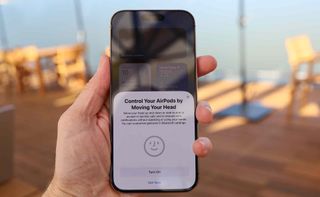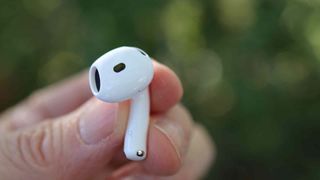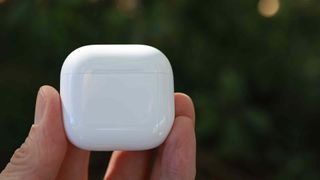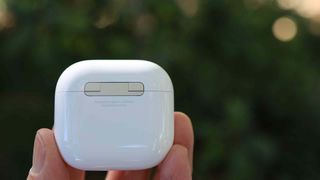Apple
AirPods
4
with
Active
Noise
Cancellation:
Two-Minute
Review
When
they’re
in
the
ear,
at
first
glance
the
Apple
AirPods
4
with
Active
Noise
Cancellation
might
not
look
much
different
to
the
third-generation
AirPods.
However,
the
design
has
been
streamlined
for
a
better
fit,
while
the
internal
hardware
has
been
upgraded,
with
many
of
the
best
features
of
AirPods
Pro
2
trickling
down
to
Apple’s
new
entry-level
earbuds,
making
them
a
tempting
option
among
the
best
AirPods.
For
one,
both
styles
of
AirPods
4
–
these
and
the
standard
version,
which
don’t
offer
noise
cancellation
–
are
powered
by
the
Apple-made
H2
chip
that
stretches
the
battery
life,
delivers
excellent
audio
playback,
and
provides
enough
horsepower
for
Apple
to
offer
Adaptive
Audio
on
the
AirPods
4
with
Active
Noise
Cancellation.
While
it
doesn’t
entirely
block
out
the
world
around
you
in
the
way
that
the
best
noise
cancelling
earbuds
do
–
remember
these
are
open-ear
earbuds
–
when
paired
with
music,
it
can
reduce
loud
rumbles,
like
a
jet
engine,
down
to
a
drastically
reduced
sound.
I
think
folks
who
desire
the
ability
to
block
out
the
world
around
them
without
fully
sealing
off
the
ear
will
find
a
nice
middle
ground
here.
The
Transparency
mode,
as
well
as
how
these
pick
up
the
user’s
voice,
is
very
well
done
and
sounds
incredibly
natural.
You’ll
also
be
able
to
answer
or
decline
calls
with
a
shake
of
your
head
and
press
the
stems
for
easy
control,
other
than
for
adjusting
the
volume.
Sadly,
the
ability
to
swipe
to
change
the
volume
didn’t
trickle
down
from
AirPods
Pro
2.
However,
excellent
audio
quality
with
a
wide
soundstage
did,
and
that’s
paired
with
support
for
Personalized
Spatial
Audio.
Overall,
the
AirPods
4
with
Active
Noise
Cancellation
make
a
bit
more
sense
over
the
entry-level
for
the
price
and
provide
some
future-proofing,
but
they
also
make
an
impact
as
powerful
open-ear
earbuds.
@techradar
♬
Relaxed
(Sped
Up)
–
MC
Mablo
Dos
Paredões
Apple
AirPods
4
with
Active
Noise
Cancellation
review:
Pricing
and
Availability
The
Apple
AirPods
4
with
Active
Noise
Cancellation
are
priced
at
$179
/
£179
/
AU$299.
They’re
available
from
September
20th,
2024,
though
are
available
to
order
already.
The
$129
/
£129
/
AU$219
entry-level
AirPods
4
do
not
offer
noise
cancellation,
or,
as
their
pricier
siblings
do,
a
Find
My-enabled
case
and
a
couple
of
other
features,
but
they
still
offer
excellent
audio
quality
and
spatial
audio
support.
Apple
AirPods
4
with
Active
Noise
Cancellation
review:
Specs
to
scroll
horizontally
| Type |
True wireless in-ear |
| Weight |
4.3 grams per earbud |
| Drivers |
A custom high-excursion driver made by Apple |
|
Battery life |
4 hours with active noise cancellation/transpareny/’Adaptive Audio’ or 5 hours with no modes engaged |
| Controls |
‘Force Stem’ on each earbud, hands-free ‘Hey Siri,’ or head gestures |
| Bluetooth |
Bluetooth 5.3 |
Apple
AirPods
4
with
Active
Noise
Cancellation
review:
Features

(Image
credit:
Future/Lance
Ulanoff)
Much
like
the
AirPods
Pro
2nd
Generation,
AirPods
Max,
or
even
the
third-generation
model
that
they
replace,
the
AirPods
4
–
with
or
without
active
noise
cancellation
–
offer
several
useful
features,
which
make
them
an
excellent
choice
for
anyone
with
an
iPhone,
or
who’s
otherwise
invested
in
Apple’s
device
ecosystem.
After
unboxing,
you
need
to
flip
the
lid
open
and
hold
the
AirPods
4
near
your
iPhone
to
start
the
pairing
process.
You’ll
see
a
prompt
appear
on
the
bottom
half
of
your
screen
and
can
click
‘Connect’
to
pair
the
AirPods
4
with
your
iPhone
and
your
iCloud
account
for
easy
syncing
between
devices.
I
found
that
this
process
took
just
a
few
seconds
to
complete.
Fast-pairing
and
quick
switching
between
devices
have
long
been
staples
of
AirPods,
with
the
former
dating
back
to
the
first
generation,
and
they
perform
well
here.
Right
after
pairing,
I
was
able
to
begin
listening
on
my
iPhone,
and
I
could
quickly
switch
to
listening
to
audio
on
a
14-inch
MacBook
Pro
or
an
iPad.
Apple’s
various
platforms
will
even
automatically
switch
your
AirPods
between
devices
based
on
what
you’re
actively
using
or
playing
audio
on,,
but
I
found
this
to
be
a
little
less
helpful.
One
very
helpful
feature
here,
though,
is
the
arrival
of
gesture
controls.
First
announced
as
an
upgrade
for
the
AirPods
Pro
2nd
Generation
at
Apple’s
WWDC
in
June,
these
head
gestures
launch
on
day
one
with
AirPods
4,
allowing
you
to
easily
answer
or
dismiss
a
call
with
a
simple
head
shake.
Just
in
my
few
days
of
using
the
AirPods
4
this
has
come
in
handy
several
times,
especially
when
my
hands
are
full
or
I’m
walking
around
town.
It
works
for
phone
calls,
FaceTime,
and
other
calling
apps
that
use
Apple’s
APIs.

(Image
credit:
Future/Lance
Ulanoff)
Aside
from
nodding
your
head
or
saying
“yes”
or
“no”,
you
can
also
press
the
stems,
or
press
and
hold,
to
trigger
a
few
actions.
A
single
press
lets
you
play
or
pause,
while
a
long
press
lets
you
select
listening
modes.
While
these
open-ear
earbuds
won’t
fully
isolate
you
from
your
surroundings,
the
AirPods
4
offer
active
noise
cancellation,
transparency,
and
Adaptive
Audio
(blending
those
two)
modes.
You
cannot,
however,
swipe
or
down
on
the
stem
to
adjust
the
volume
– the
ability
to
do
this
on
the
AirPods
Pro
is
super-handy,
but
seemingly,
Apple
wants
to
keep
that
feature
for
its
flagship
earbuds.
Apple’s
H2
chip
–
the
same
chip
found
in
AirPods
Pro
–
powers
all
of
these
features,
as
well
as
the
microphones,
custom
algorithms,
and
sensors.
As
I
wrote
in
my
hands-on
review,
after
I
tried
the
AirPods
4
with
Active
Noise
Cancellation
right
after
the
launch
event
to
quiet
down
a
noisy
space,
they
offer
seriously
impressive
noise
cancellation
for
open-ear
earbuds
or
buds
that
don’t
fully
seal
off
the
ear.
In
that
space,
with
ANC
engaged,
the
sound
of
the
crowded
space
was
muffled,
and
when
music
playback
began,
it
was
mostly
quieted
down.
On
an
airplane,
it
was
much
the
same
experience
–
you
can
get
some
peace
and
quiet
with
them,
but
they
won’t
fully
drown
out
the
environmental
noise
as
the
AirPods
Pro
can.
Part
of
this
might
be
due
to
the
fact
that
your
body
is
feeling
vibrations
and
wants
to
match
them
with
sound,
but
I
think
another
factor
is
that
without
the
full
seal
and
as
you
move
your
head,
ambient
sound
has
more
opportunity
to
enter
your
ear.
The
result
is
that
AirPods
4
block
out
most
sound,
but
on
an
airplane
–
or
a
train
–
you’ll
still
hear
the
engine
roar
and
even
some
cabin
noise.
Still,
though,
these
effectively
block
out
a
lot
of
noise.
I’ve
long
thought
that
the
AirPods
Pro
offered
the
best
transparency
mode,
in
which
they
intelligently
let
environmental
sounds
in
and
lower
the
decibels
so
as
not
to
harm
your
ears.
I
think
the
AirPods
4
outpace
those,
though
–
with
transparency
mode
enabled
here,
any
sense
of
roboticness
or
noise
being
piped
in
is
pretty
much
removed;
with
Conversation
Awareness
turned
on,
you
can
also
effectively
have
conversations
with
folks
quite
naturally,
at
times
even
forgetting
these
are
in
your
ears.
Your
own
voice,
or
in
this
case
my
voice,
sounds
a
bit
more
natural
and
less
processed
as
well.
Apple
AirPods
4
with
Active
Noise
Cancellation
review:
Design

(Image
credit:
Future/Lance
Ulanoff)
The
AirPods
4
with
Active
Noise
Cancellation
don’t
stray
too
far
from
the
working
formula
of
Apple’s
other
true-wireless
earbuds.
They
opt
for
short
stems
like
the
AirPods
Pro
or
the
AirPods
3rd
Generation
that
these
directly
replace.
The
curved
portion
of
hard
plastic
that
sits
in
your
ear
has
been
slightly
redesigned
and
is
now
more
curved,
to
provide
a
better
fit
in
the
ear.
I
found
the
AirPods
4
to
be
pretty
cozy
in
my
ears.
I
comfortably
wore
them
for
over
four
and
a
half
hours
while
on
a
flight
and
for
countless
hours
with
intermittent
usage
while
working.
They
still
just
kind
of
plop
in
your
ear
and
rest
there.
I
didn’t
have
them
fall
out
on
any
occasion,
whether
on
a
turbulent
flight,
while
working
out,
or
while
walking
indoors
and
outside
in
a
bustling
city.

(Image
credit:
Future/Lance
Ulanoff)
The
case
is
downright
tiny
given
the
smaller
footprint
that
the
left
and
right
AirPods
4
with
Active
Noise
Cancellation
take
up.
It’s
much
smaller
than
the
AirPods
Pro
2nd
Generation
case,
and
even
the
case
for
the
cheaper
AirPods
4,
and
is
shorter
than
the
AirPods
2nd
Generation’s
case.
You
still
flip
it
open
to
take
out
or
put
back
your
AirPods
4,
and
there’s
a
multi-purpose
indicator
light
on
the
front.
There’s
no
back
button
on
the
back
case
for
easy
pairing,
though.
Instead,
you’ll
double-press
the
back
to
trigger
pairing
for
other
devices,
including
non-Apple
ones.
It’s
an
easter
egg
that
Apple
needs
to
publicize
a
bit
more.
To
charge
the
AirPods
4,
you
can
plug
them
in
via
USB-C,
though
there’s
no
longer
a
charger
in
the
box.
If
you
get
the
AirPods
4
with
Active
Noise
Cancellation,
you
can
also
place
them
on
any
Qi-wireless
charger
or
Apple
Watch
charging
puck.
In
my
testing,
I
found
that
with
active
noise
cancellation,
transparent,
or
Adaptive
Audio
enabled,
you’ll
get
around
four
hours
and
15
to
20
minutes
of
usage.
That’s
beyond
Apple’s
promised
four
hours
of
playback
with
a
listening
mode
enabled.
With
no
mode
on,
you
can
get
about
five
to
five-and-a-half
hours
of
playback,
depending
on
the
volume
you’re
listening
at.
A
quick
five
minutes
of
charging
in
the
case
also
provides
at
least
an
hour
of
listening.
Apple
AirPods
4
with
Active
Noise
Cancellation
review:
Sound
Quality

(Image
credit:
Future/Lance
Ulanoff)
To
sum
up,
the
AirPods
4
essentially
sound
as
good
as
AirPods
Pro
2nd
Generation,
and,
as
with
their
predecessors,
that’s
without
the
buds
providing
a
true
seal
of
the
ear.
There’s
a
clear
and
rich
audio
mix
with
a
fairly
wide
sound
stage,
but
the
real
chef’s
kiss
here
would
be
the
Spatial
Audio
support.
Powering
the
audio
experience
is
Adaptive
EQ
via
the
H2
chip,
and
pushing
out
sound
is
a
custom
high-excursion
drive
and
a
high-dynamic
range
amplifier.
It’s
also
worth
noting
that
there’s
a
single
H2
chip
in
each
bud,
with
audio
sent
over
Bluetooth
5.3
from
the
connected
device.
This
all
comes
together
to
give
you
a
balanced
representation
of
the
track
you’re
listening
to,
but
if
you’re
listening
to
something
that
bops
with
more
oomph
the
AirPods
4
with
Active
Noise
Cancellation
won’t
shy
away
from
raising
the
lower-end
or
really
offering
a
surprising
amount
of
bass
for
earbuds
of
this
size.
For
instance,
with Burnin’
Train by
Bruce
Springsteen,
the
track
starts
off
with
a
rising
guitar
riff
that’s
quickly
joined
by
drums,
piano,
and
vocals
all
across
the
sound
spectrum
–
it
sounds
sonically
here
and
in
lossless
via
Apple
Music
I
didn’t
notice
any
distortion
or
dropouts.
With
a
pop/EDM
track
like
Apple
by
Charli
XCX,
you
can
see
how
the
AirPods
4
handle
layering
of
sound,
with
a
surprisingly
sharp
bass
track
that
doesn’t
distort
with
the
singer’s
vocals
on
top
at
higher
frequencies,
with
various
electrical
beats
in
between.
The
AirPods
4
tend
to
handle
almost
all
genres
well,
and
even
without
a
full
seal,
deliver
a
great
balanced
mix,
although
at
higher
volumes
you
will
have
some
sound
leakage.
Spatial
Audio
here
essentially
gets
rid
of
stereo’s
left
and
right
channels,
with
various
elements
of
a
track
flowing
around
you.
It’s
a
more
immersive
listening
experience,
and
Apple’s
implementation
here
is
excellent.
I
particularly
like
spinning
it
with
a
live
track,
but
I
think
the
album
version
of
Down
On
The
Corner
by
Creedence
Clearwater
Revival
is
one
of
the
best
examples.
Not
to
mention,
it
also
works
with
some
movies
and
TV
shows
to
put
you
right
in
the
middle
of
the
action.
Apple
AirPods
4
with
Active
Noise
Cancellation
review:
Value

(Image
credit:
Future/Lance
Ulanoff)
At
$179
/
£169
/
AU$279
with
active
noise
cancellation
or
$129
without,
AirPods
4
offers
a
variety
of
features
previously
found
only
on
Apple’s
most
high-end
earbuds.
The
new
design
language
streamlines
the
AirPods’
appearance,
as
they
all
look
similar.
If
you’re
sold
on
open-ear
earbuds
or
ones
that
lack
silicone
tips,
AirPods
4
are
likely
your
best
bet
if
you
want
to
be
within
Apple’s
ecosystem.
The
higher
price
might
only
be
$70
away
from
AirPods
Pro,
but
you
still
get
a
lot
of
value
for
the
price:
three
listening
modes,
a
comfortable
open-ear
design
that
doesn’t
fall
out,
solid
battery
life,
and
a
findable
case
should
they
go
missing.
The
$129
/
£129
edition
of
AirPods
4
will
lose
the
listening
modes
and
the
Find
My
enabled
case,
but
it
still
offers
a
rich,
crisp
audio
experience,
all
of
the
handy
Apple
ecosystem
features,
and
support
for
Spatial
Audio.
Should
I
Buy
Apple
AirPods
4
with
Active
Noise
Cancellation?
Buy
them
if…
Don’t
buy
them
if…
How
I
tested
Apple
AirPods
4
with
Active
Noise
Cancellation
For
the
past
several
days,
I’ve
been
living
with
and
using
Apple’s
AirPods
4
and
AirPods
4
with
Active
Noise
Cancellation
with
an
iPhone
15
Pro
Max,
iPad
Mini,
iPad
Pro,
14-inch
MacBook
Pro,
Apple
Watch
Ultra
2,
and
Apple
TV
4K.
I
tested
audio
playback,
standard,
and
Spatial
Audio
tracks
in
various
locations
to
gauge
and
track
performance
and
see
if
there
was
sound
leakage
since
these
are
open-ear
earbuds.
I
threw
various
tracks
across
genres
at
AirPods
4,
streamed
from
Apple
Music,
Spotify,
YouTube
Music,
and
Nugs.net.
I
used
active
noise
cancellation,
transparency,
and
“Adaptive
Audio”
listening
modes
in
various
locations,
including
at
home,
in
an
office
environment,
while
walking
around
a
city,
on
a
train,
in
a
car,
and
on
a
plane.
I
tracked
and
measured
how
long
the
battery
lasted
with
these
modes
on
and
off
and
the
charging
time.
-
First
reviewed
September
2024.
